What is Frostbite?
Frostbite happens when your skin is exposed to freezing temperatures. Frostbite damages areas of your skin and sometimes even damages the tissue underneath. It is treatable, but it can be a very serious condition. HHS says it can take as little as 30 minutes for frostbite to begin to set in. So it is very important to pay attention to the early signs of frostbite.

Different Stages of Frostbite
If you are experiencing redness or sore skin, you are probably entering the first of three stages of frostbite. You can find the different stages and their symptoms listed below.
Early stage – your skin begins to turn a pale yellow, almost white color. During this stage, the exposed area may itch, sting, or even burn.
Intermediate stage – the affected area of skin will begin to harden, and the surface of the damaged area will look shiny or even waxy. When the skin thaws from this stage blisters full of puss or blood will form on the frostbitten area.
Advanced stage – during this stage, the area of skin will be very hard and cold to the touch. The skin will also darken quickly, turning black or blue.
Frostbite Treatment
You can treat frostbite at home depending on the stage, if it is severe, it is recommended yoh get it treated at the hospital.
- At home frostbite treatment
- First, get to a warm place to begin to thaw the cold or frozen area. Do not place frostbitten skin into hot water. Doing this could further damage your skin or tissue. Instead, place the damaged area of skin into warm water or use a warm washcloth. As your skin begins to thaw it may sting or become red.
- Hospital frostbite treatment
- Your nurse will try to warm you and restore blood flow to the affected area. Warm sponges may be placed onto the frozen areas of your skin. The hospital may provide you with pain medicine for the nerve pain and tissue damage. You can also expect to have an MRI taken to determine how deep the damage went. They also may scrape skin off of the affected area
Preventing Frostbite
According to the Center of Preparedness and Response, the best way to prevent frostbite is to layer yourself with clothes that allow your body heat to travel. The most common places to get frostbite are the fingers, toes, ears and nose. So don’t skimp on covers such as sock and gloves.
For more information on frostbite and how to treat it, please visit the Hard Hat Training Series!
